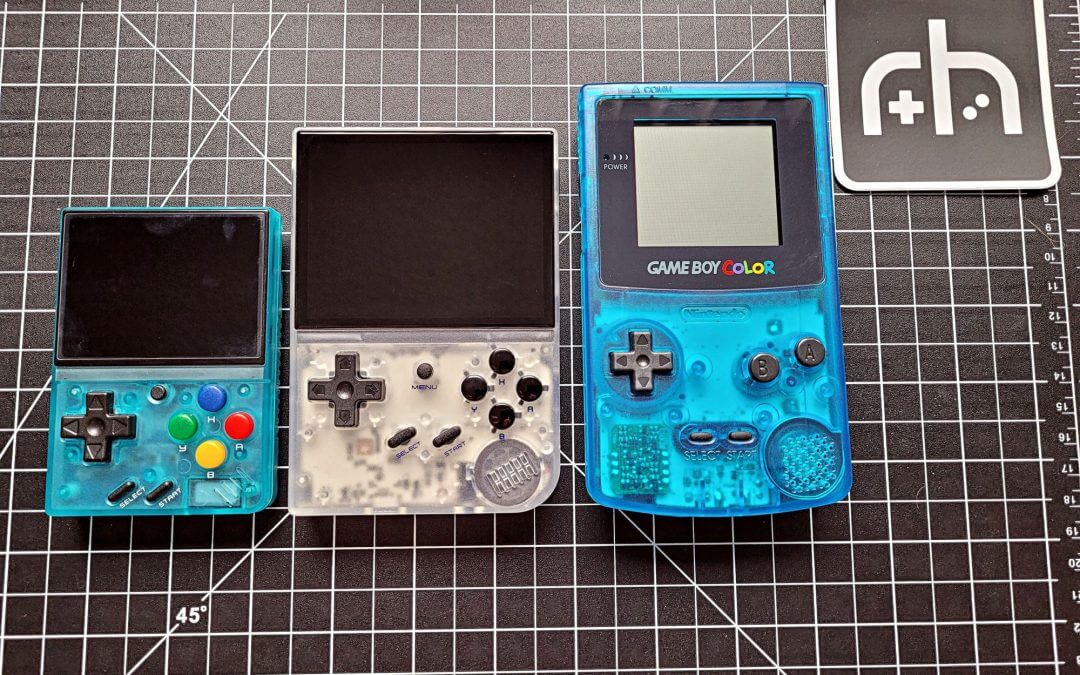Hey there my party people, we’re going to be doing something a little bit different with this review. This will be a dual review, a head-to-head of sorts, pitting both the likewise and the contrary opinions of two of our writers on this shiny new device against each other. Raven Mage and Rocketman824 shall henceforth be referred to as Raven and Rocket for the remainder of this review, for conciseness, so let’s get it started.
Raven: So it looks like Anbernic is trying to chew into Miyoo’s market here with the Mini. Of course, the primary competition it would seem they’re attempting to provide is power and price, because size is still firmly in the diminutive Miyoo Mini’s corner. This device’s size skews much closer to its bigger brother the 353V, but with a price point starting at $55.99 it has certainly made a few concessions in features and power to make that kind of cut. Did they shave too close to the corners, or is this the perfect budget product to hand over to your destructive little cousin for his birthday?
Rocket: Is it a backlit DMG? Is it a big Miyoo Mini? Is it a Retroid Pocket 4?? I mean, no it’s not any of those and honestly that’s pretty obvious. But, what IS it?
Raven: Are you having a stroke right now?
Rocket: May I introduce to you the Anbernic 35xx; the intriguing, vertical, screen-heavy, cheap(ish) new device from the folks that produced the classic 350 line. It’s a handheld in the vein of their 353V(S) that inserts itself into the ring with other affordable but capable devices. With a big screen and small price tag, this thing could be a sneaky contender for your constant ‘pocket-pal.’ But let’s not get too far ahead of ourselves here. We still have a plethora of great devices out in the retro-verse and many of them have cemented themselves as high-quality or high-value systems, sometimes both. Can the 35xx hang with the big boys? Can it knock off a few of the kings of the lower class? Can it play cartridges? Well, the answer to that last one is literally 100% no.
Raven: Was this feature in doubt? ARE YOU HAVING A STROKE RIGHT NOW?
Rocket: However, if you’re curious about the answers to the others, stick around. I’ll go over the dirty details with you, and provide you with some perspective on this brand-new entity in the ever-evolving world of retro handhelds. Under the microscope now: The 35xx by Anbernic.
Hardware

Raven: So the hardware in this device is a bit of an interesting story. On paper it’s stated to have a quad-core Cortex-A9 ARM CPU, and a quad-core PowerVR SGX544MP GPU. However, in practice, some sniffing around by CFW developers have revealed that the GPU is actually not being utilized by the code at all. Kind of a strange limitation to incorporate, and it’s unclear why Anbernic would do this outside of speculation. This is paired up with a rather sparse amount of RAM, being only 256MB of DDR3, though this shouldn’t present an outright issue with any of the systems this device supports.
Rocket: Yeah, real interesting story Raven, thanks. Had us by the edge of our seats. Now that all the fancy-schmancy numbers are out of the way, let’s talk about what that means for the actual playing of actual games. With the power inside this little guy the ceiling really is PS1, though everything up to and including PS1 should be quite playable. The GPU as of now is actually not being utilized by the stock OS, but will hopefully be unlocked soon by the amazing folks working on developing custom firmware for our friendly DMG clone (more on that later). Nevertheless, this device has enough power for its purpose, which to me is providing quick play sessions on older generation games while still providing a suitable playable library.
Raven: We’re going to go into more detail on what it can play later Rocket, but thanks for that, you sarcastic bastard. Anyway, storage is really familiar if you’ve owned any Anbernic handheld in recent years. Since it’s running a Linux image, the 35xx sports the usual dual SD slots, with the primary slot being intended for the firmware image, and the second being intended for bulk storage of games. This, as usual, provides the ability to reflash the firmware without losing what could be a sizable collection of games you’ve transferred to the device.
The battery is a decent capacity, at 2100mAh, which in testing has been shown to get roughly the stated estimate from Anbernic of roughly 5 hours of play.
Rocket: Though when playing PS1 games in particular, I noticed that the estimate should be closer to 2-3 hours.
Raven: Thankfully, upgrades for this battery have already been spotted within the community, which will add even more time between your charging cycles. Lastly it should be fairly easy to sum up the remainder of the hardware features, as there are only a few left, including the USB-C charging port and 3.5mm headphone jack on the bottom, and the mini-HDMI port on top of the device for output to the TV. It does not feature any bluetooth or wifi functionality.
Rocket: The HDMI out option is also there for people who are into that, though it’s not a device I would expect to be used much in that way as it lacks Bluetooth and Wi-Fi connectivity. A mono-speaker gives off decent sound but is easily covered by your hand while playing, hampering the experience a bit.
Raven: Wait, no, dude, I already said- nevermind…
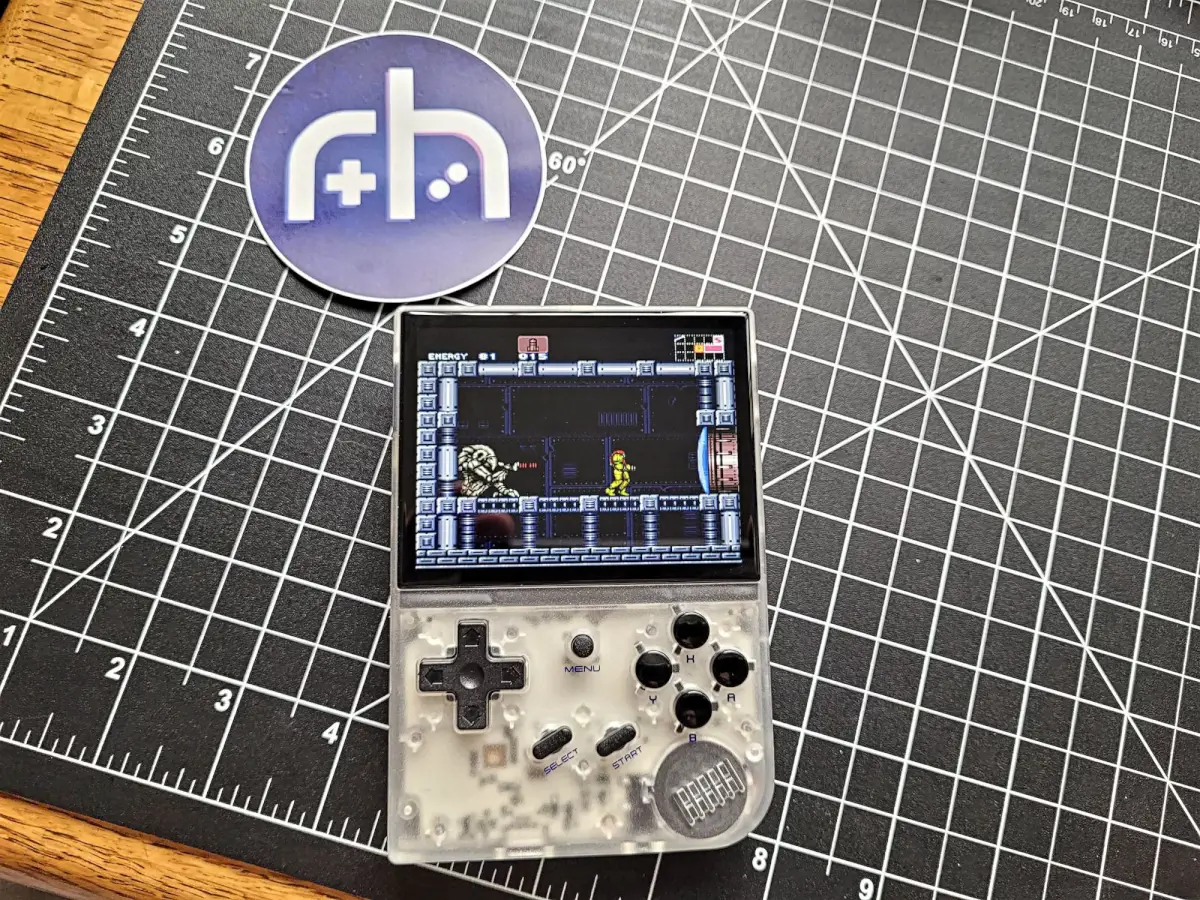
Raven: Let’s talk screen for a second. This is a 3.5 inch 640×480 resolution screen in similar fashion to most of their recent devices. However, this particular screen doesn’t quite seem to match up to the quality of some of their 353 screens, suggesting perhaps that this is somewhere it makes up for the price difference. It doesn’t have a touchscreen like the 353 devices, after all, so it stands to reason this component could be changed. It gets bright enough, it gets dim enough, and it has enough color reproduction and sharpness to make most people happy, it just doesn’t wow quite the same as other recent screens. It’s… good enough. Unfortunately, my particular display has a fairly significant amount of backlight bleed, an issue I have seen observed by other members of the community with their units as well. It’s not significant enough, at least for me, to affect gameplay, but during dark screens it’s very distracting.
Rocket: The screen takes up half of the real estate on the front of this little guy, which is honestly great. It’s a 3.5 inch IPS display with a 480p resolution making it a solid looking screen for such a cheap device. I will say right off the bat that the device I got came with a screen that is a bit off center (noticeably so) and also has a darker section all along the bottom. I’m not sure how many of them come like this but it’s something I wanted to make people aware of, as it doesn’t bother me a terrible amount, but I know screen-o-philes (maybe?) would be a bit disappointed by this.
Raven: I’m… pretty sure it’s not screen-o-philes, Rocket.
Rocket: Well maybe it should be. With that out of the way I still say that, for the price, getting a screen this size is nice. Gameboy Color games look nice, Genesis games pop, SNES games have the color and saturation to make them look pretty. Fiddling with various filters, colorizations and the like can help you see each game as you’d like it to be. I noticed no tearing. I also noticed the brightness and just how adjustable it is: eight levels that range from very dim to quite bright. The changes are noticeable and much appreciated. I do find the sharpness a bit lacking compared to something like the Miyoo Mini but it’s still serviceable. My overall thoughts on the screen boil down to this: the screen is big, bright, colorful, and functions smoothly. It holds it’s own without blowing anybody away. As far as price of device vs. screen quality? The 35xx has serious value.
Inputs and Comfort
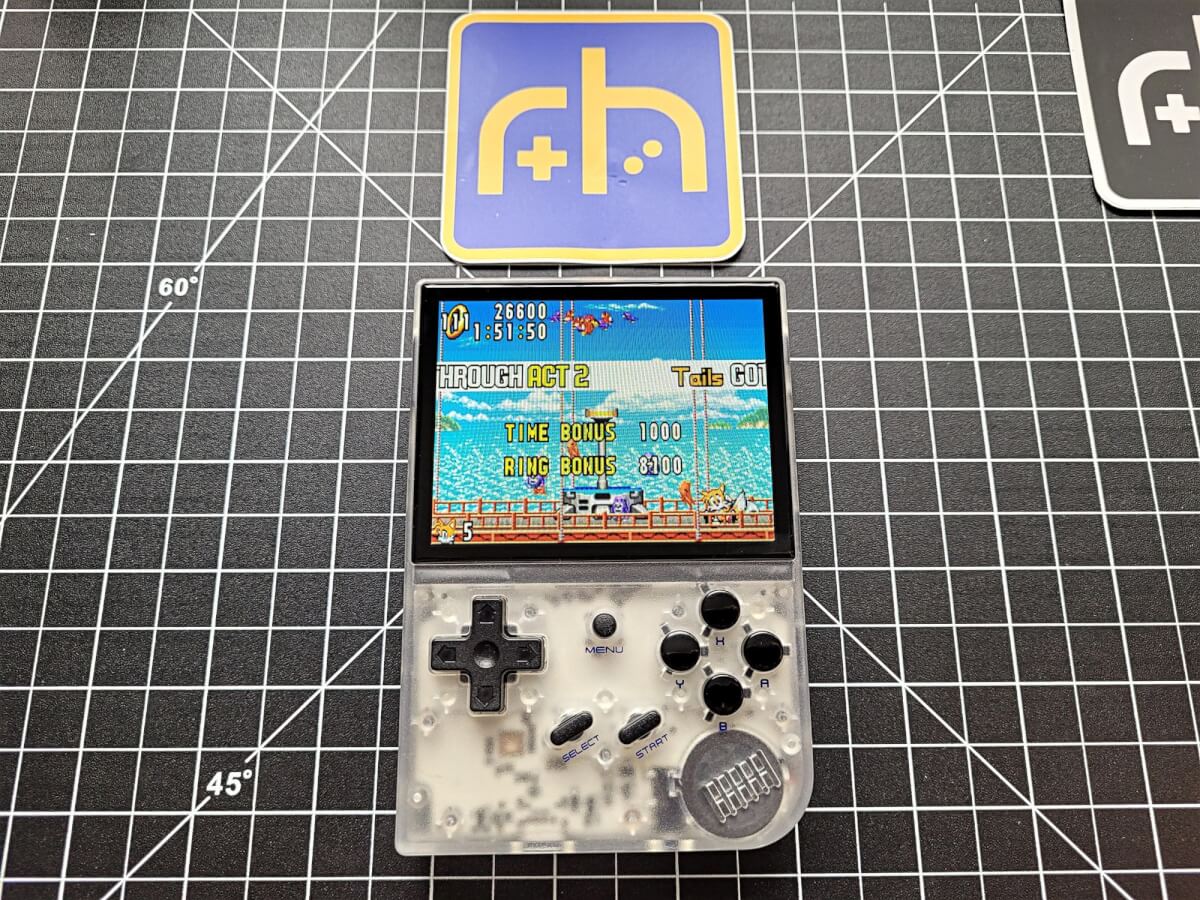
Raven: If you’re looking at the RG35XX and wondering “is that just the RG353V with the analog sticks chopped off?” Yup, that’s basically it. While the internals may be vastly different, the plastic quality and overall dimensions (minus a bit of height from losing those awkward sticks) are almost identical. It measures at 11.7cmx8.1cmx2.0cm (4.6inx3.2inx0.8in) which puts it at roughly the same width and thickness as the 353V but loses about a centimeter in length. More than the dimensions, the removal of the analog sticks is the real addition to the pocketability of the device.
Rocket: Right out of the gate I have to say that I am a vertical handheld fan; I prefer them over horizontal devices most of them time. So the fact that the 35xx is vertically oriented is an early plus. It stands in stature like a wider but shorter GBP, with a screen that takes over half of the entire face. The plastic is sturdy and supple in the hands and is actually one of the nicer things about the device. The texture of the shell and the D-pad are top notch in fact. The face buttons are glossy (much like a similar, smaller, more famous-er device) and speaker slots in the bottom right are straight out of the DMG playbook.
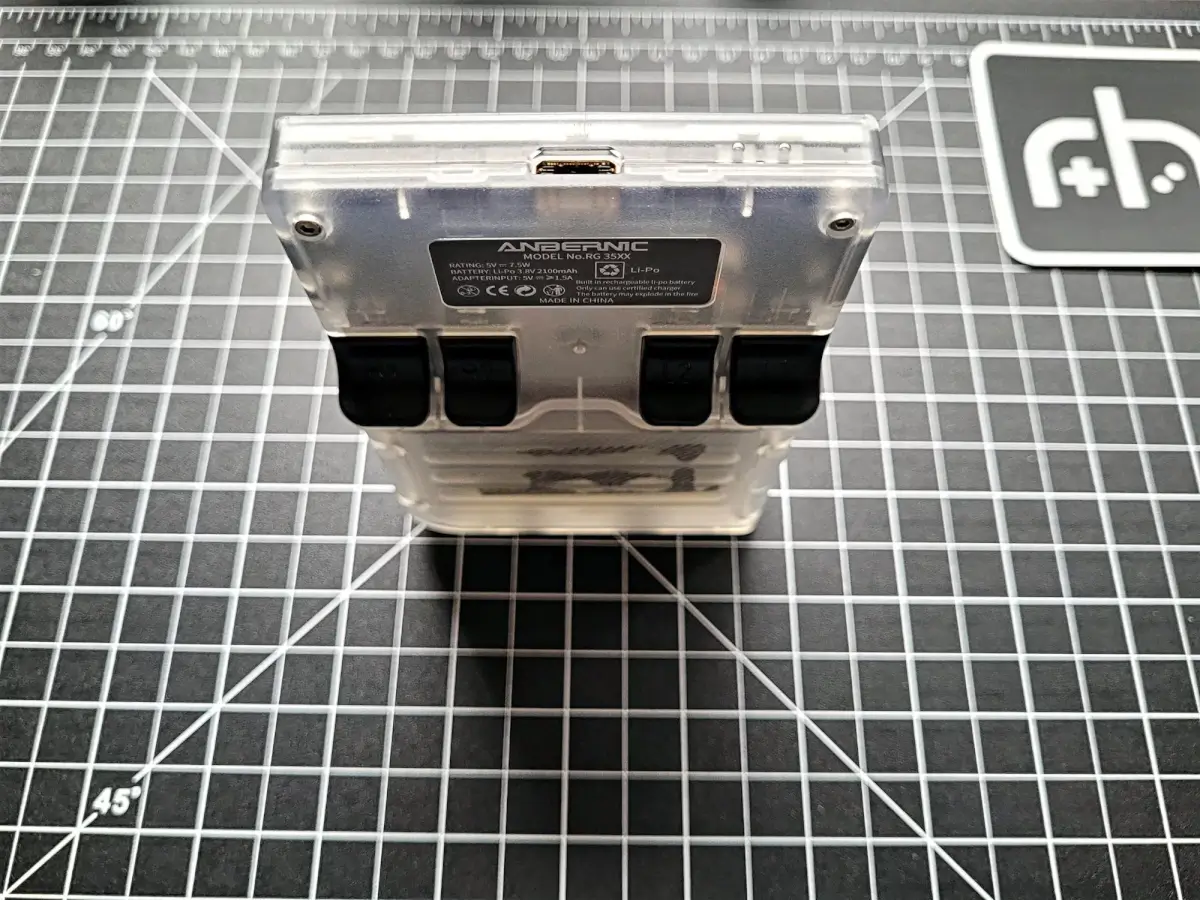
Raven: Are we really going to have to praise Anbernic’s buttons again? Like, every review, we gotta say that yeah, Anbernic have nailed the rubber membrane. Whatever else you can say about them, the dpad and face buttons on Anbernic handhelds are always superb.
Rocket: This will not come as a shock to anyone who has used an Anbernic device before: the buttons are on point. The face buttons feel good under the thumb and are responsive and mushy all at once. What about the D-pad, you may be asking? Well, it straight up ROCKS. The matte sort of finish mixed with a great size and impeccable functionality allow it to live up to Anbernic’s amazing reputation with directional pads.
Raven: Hey now, they’re not paying us for this to be a shill piece or anything. While, as I mentioned, superb, I personally don’t really enjoy the move to the glossier finish on the face buttons. The more textured finish on the 353V was preferable, but I will agree that the dpad is great as usual. It is a bit baffling they went with a textured dpad but not buttons, to be honest.
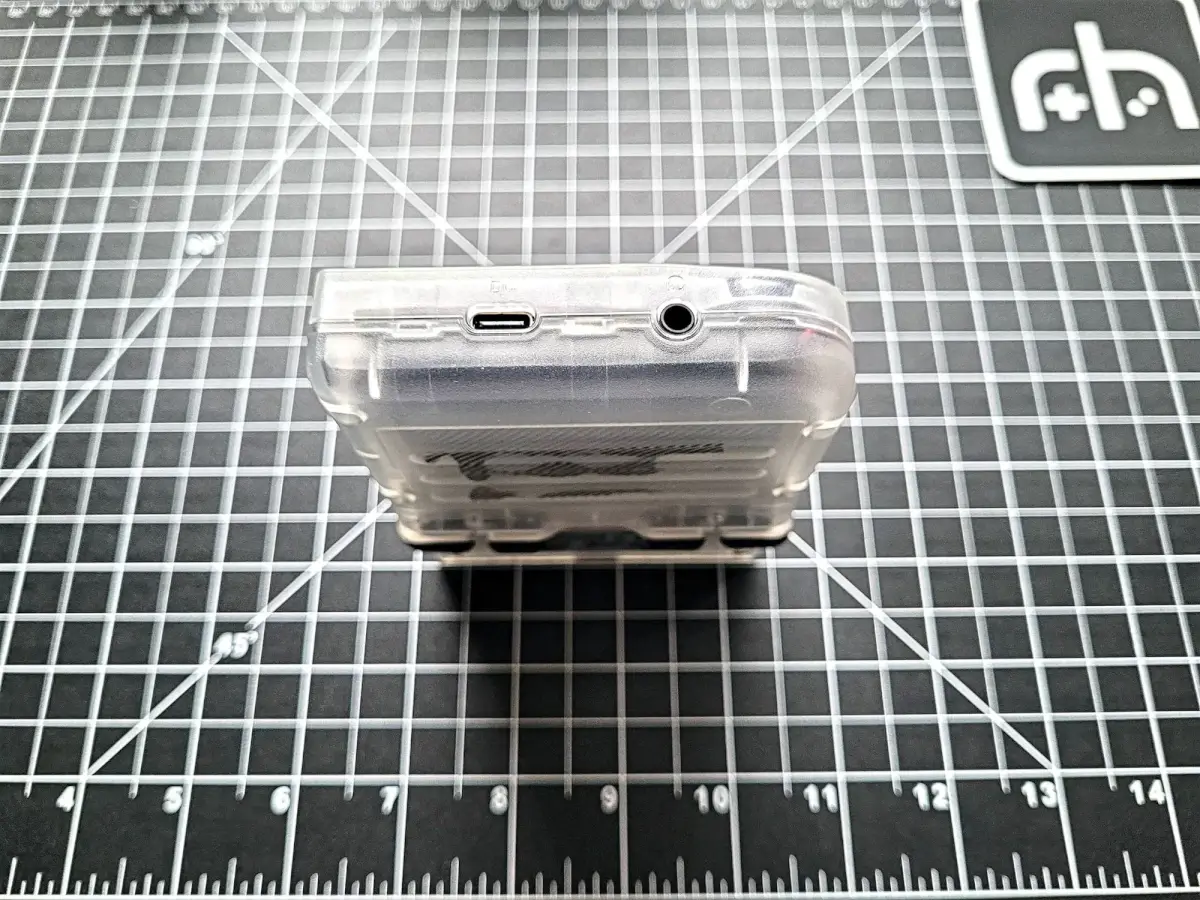
Rocket: A central Menu button sits above the angular Start/Select buttons, finishing off the face in a respectable way. Around the sides you’ll find Power and Reset buttons on the upper right, and a volume rocker on the upper left. Menu, Start and Select are all similar with a little bit more of a click than the face buttons have. The buttons around the edges are much more clicky and they work great for their various functions.
Raven: Yeah, these buttons are all nice enough considering their secondary nature. The menu start and select have some sort of membrane underneath, but since the start and select are a hard plastic they don’t manage to be extra squishy like a GBC’s start and select. The power button and volume rocker aren’t recessed like they have been in certain recent models, but thankfully the reset button is. Don’t need to be accidentally whacking that during a particularly intense game of Tetris.
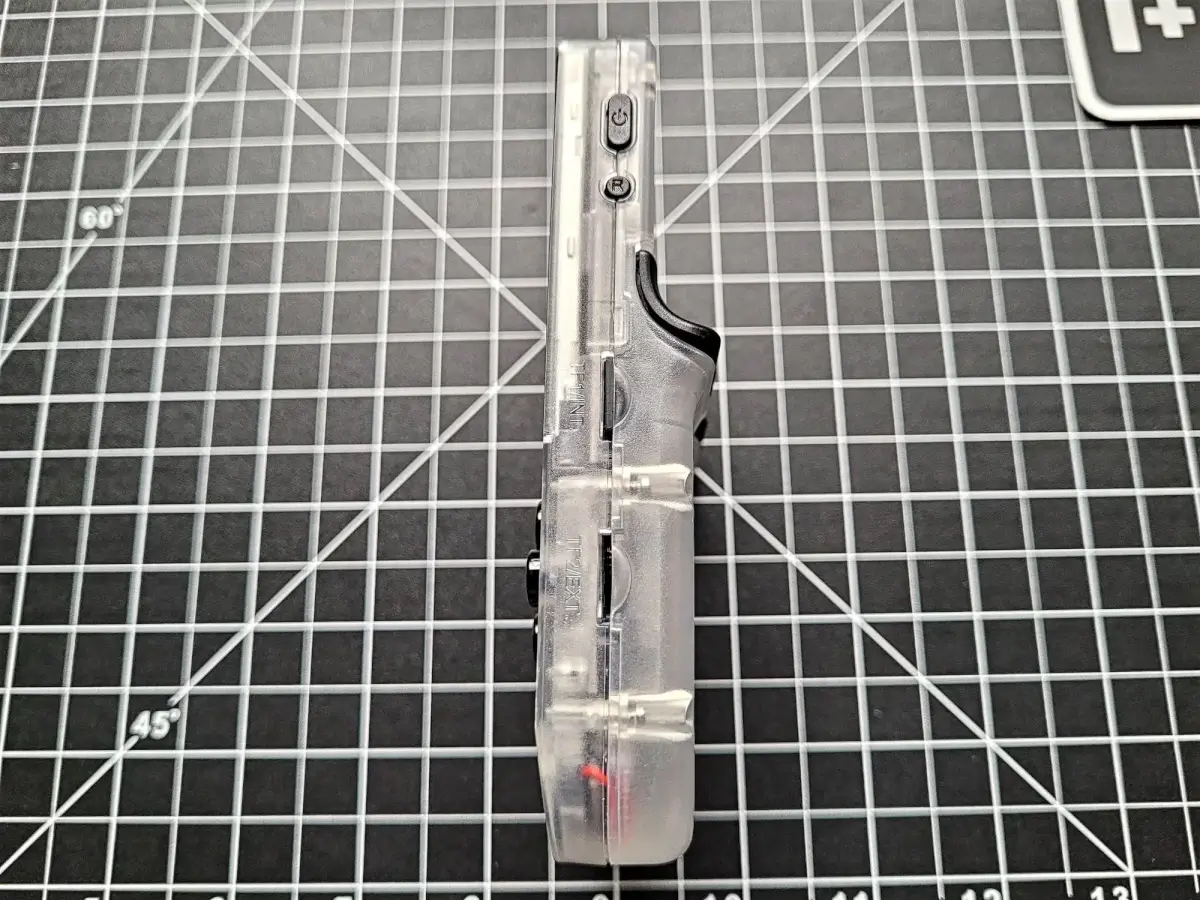
Rocket: The good news may end here as far as the buttons go, unfortunately, because the shoulder/trigger buttons on the back are subpar at best. Besides being goofy looking they are also a bit awkward to use. Reaching for the innermost two will often leave you pressing the outer ones as well whether you want to or not. After a while, my fingers got really tired of resting on the buttons but trying not to actually touch them. They have a nice curve to them and they are easy to press down (which is both nice and naughty all at once) while their placement on the back of the device is in a conveinient spot. So they are by no means the worst back buttons I have ever used, but I just find them to be a bit of an afterthought, both for the producers and consumers of this handheld.
Raven: I’m gonna do a lazy thing.
Rocket: Uh-oh.
Raven: In my defense, it’s because Anbernic did a lazy thing. These are the same exact L1/L2 R1/R2 that were on the 353V, so I’m gonna say the same thing I said then.
“On the rear of the device, we don’t find much except the L1/L2 R1/R2 triggers. They’re clicky, they’re responsive, that’s good. However, they’re the same height and length and therefore end up feeling identical during gameplay. Not to mention that at least for myself I was forced to crook my index fingers in an odd manner to specifically click on the L2/R2 without bothering the L1/R1. This is not helped by the fact that they are extremely sensitive and will often be heard being triggered when pressed up against the inside of a bag or pocket. This is definitely a factor of the design where I feel they got it “almost but not quite” right.”
They still didn’t fix this issue, and so these still end up being very meh. Thankfully there are now producers within the crafting community that are making upgraded shoulder buttons for this similar to the ones for the Miyoo Mini. However, my other complaint that wasn’t present within the 353V review is that you kind of have to maintain full pressure on these triggers, at least in my unit. Letting up even a bit, despite the fact that it doesn’t seem to release the micro-switch inside, can often result in the trigger no longer registering the press, which can be frustrating when you need to hold the trigger down for longer periods of time.
Rocket: If I had to give the buttons on this device a grade, it’d be a strong 85%.
Raven: I’m going to go with a slightly more critical 70% here, to be honest. With community crafted shoulders and face buttons we’ll be sitting much prettier, but it’s a shame we have to shell out extra money on aftermarket goods to make this device feel its best.
Software and OS
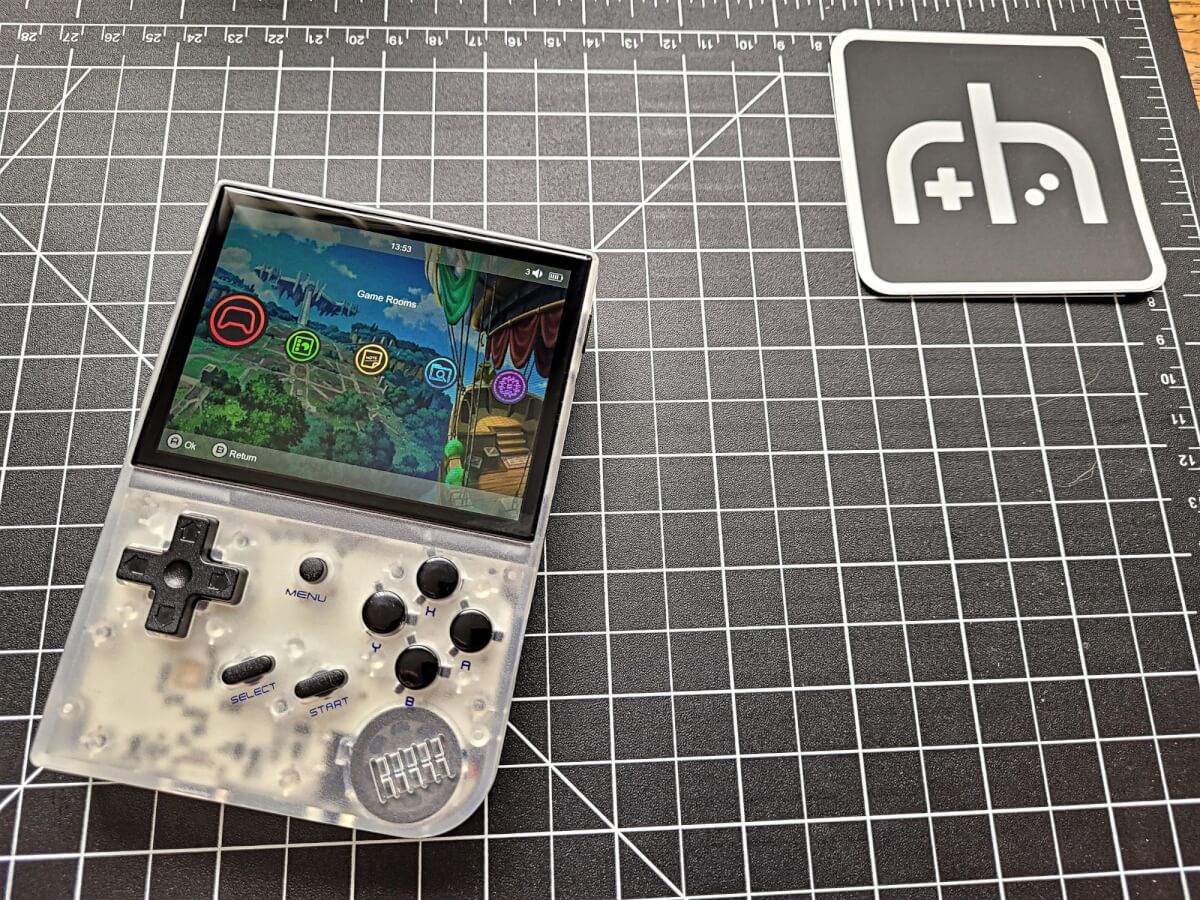
Raven: Honestly, I reviewed this thing with the Stock OS that comes pre-installed, and I’m not going to have a whole lot to say other than that you should probably look into the custom firmware options for this device. It has become an unfortunate trend with these manufacturers, Anbernic being chief amongst them, to kind of include a half-baked operating system and expect the community to pick up the slack. It’s fine if you’re handing this handheld off to a little kid or something, they probably won’t notice, but it barely makes a minimum grade here. Limited file format support, poorly translated menu options, no aspect ratio settings, very limited customization at all. Like I said, if you really don’t care, or the target user doesn’t, then this makes the minimum grade of playability and I was able to get through a gamut of titles from all the supported systems with no real issues besides all the stretched pixels. For our personal recommendation, though, I’ll hand this over to the man who didn’t draw the short straw on operating systems to test.
Rocket: HERE is where things get interesting. Unless of course, you’re more interested in the hardware side of things, in which case it got interesting a while ago. As usual, this Anbernic device comes shipped with their idea of an operating system, some firmware that is half-baked and not in a fun way. However, we are lucky to have angels among us who provide light in the darkness. Introducing the fix to your stock OS woes: GarlicOS. Based off of the Miyoo Mini OS Onion in both name and style, this CFW was being developed almost immediately after the developer got their hands on a 35xx. It’s a big upgrade from stock for many reasons, and after using it for about a week, I gotta say, I’m a fan. The way it looks and the way it runs both work for me. The style is simplistic, clean, easy to understand, and convenient, making it a great firmware for newcomers to the hobby.
GarlicOS greets you with a simple start-up screen upon firing up the device: four sections each with clear and distinct purposes. There’s a “Recent” tab for heading straight into your recently played SNES RPG’s (or any other assortment of letters that stand for games), and a “Favorites” tab for placing all of your Pokemon romhacks into. “Consoles” allows you to see each of the various consoles and devices for which you have games stored on the SD card, and finally a “RetroArch” tab for using and configuring the program which drives the game-playing on the 35xx. The menu is very fast and easy to navigate. It’s snappy. It really is a great design for a device that you want to pop in and out of your pocket a few times a day to grind some levels in a classic platformer.
The firmware provides all of the versatility and features of RetroArch allowing things like fast-forward, save states, and shaders to be utilized to your liking. It also provides a fairly accurate, easy to see battery monitor up in the right corner of the home screen. The ease-of-use continues, with a favorite game being able to be added to your list with the push of a button, games to be opened and resumed quickly through the “Recent” menu, and the actual Menu button on the device is used to exit and save a game quickly. Hotkeys are in place during gameplay as well, providing ways to use fast-forward/reverse functions with the trigger buttons, and allowing access to the RetroArch menu in-game with a combo of holding Menu and pressing X. GarlicOS is a solid piece of software that has already helped make the 35xx better, and with regular updates and added features, it will simply be a must for the device. On top of all that, it’s easy to flash to an SD card and get it running. I simply cannot suggest it enough. If you have a 35xx, season it up with some Garlic, ASAP.
Raven: Yeah we’re still not getting paid for this shill piece either, Rocket, but I agree with you. Thanks to the inclusion of the Retroarch backend, you get all the tinkering and tweaking settings you need to correct the scaling on systems, configure your control layout, and it’s all under much more active development than the StockOS, with the developer putting out frequent updates to improve the already superior choice of operating system. Oh, and you can actually use CHD files for your PS1 games, rejoice!
So What Can It Play?
| Fully Playable |
|---|
| Atari 2600, Atari 5600, Atari 7800 |
| Nintendo Entertainment System |
| Super Nintendo Entertainment System |
| Nintendo Game Boy |
| Nintendo Game Boy Color |
| Nintendo Game Boy Advance |
| Nintendo Virtual Boy |
| Sega Master System |
| Sega Genesis / Mega Drive |
| Sega 32X |
| Sega CD |
| Neo Geo Pocket |
| Neo Geo Pocket Color |
| Sony Playstation |
| Not A Chance |
| Nintendo 64 |
| Nintendo DS |
| Sega Saturn |
| Sega Dreamcast |
Raven: Unlike some of our recent reviews, we’re not going to be seeing systems on this list that really push beyond the hardware capability of the device. With the Linux firmware having a limited list of supported systems, we’re not even capable of testing something more difficult to emulate like N64 or Dreamcast. The PS1 will likely be the most powerful system supported on this device unless future updates from CFW offer extra systems for some reason. This simplicity is probably a good thing, however, as we won’t be having sketchy claims about N64 or PSP compatibility like we all remember hearing about the 351 line of devices. Instead, you just get 8-bit up to PS1, and it all pretty much works, though obviously on Garlic some games will depend on differing cores.
Rocket: This Anbernic is not as strong as some of their recent devices, such as the 353 line, but for its size, style, and overall goal as a handheld, I think it thrives. That goal being: a Gameboy game player that can also play PS1 very well. I tested games from the GB, GBC, GBA, SNES, Genesis, and PS1 libraries, and to my surprise, everything ran great. Even NBA Live 2003 ran well and I have had spotty luck with that on most devices that claim awesome PS1 performance. Overall the performance was stellar while running on GarlicOS and it’s pretty impressive considering this device comes in at around the $60 mark. I saw (or heard) no stuttering, I never noticed slowdown of any kind. In fact as I played 2K3, I forgot I was just testing the performance of it, because I was having fun just playing the game. I actually ENJOYED the experience of playing games on this thing, and ultimately, isn’t that what matters most?
Conclusion
Raven: I haven’t been particularly nice to this device over the course of this review, or to my fellow reviewer I suppose. But hey, being a jerk is part of my charm I like to think.
Rocket: YOU like to think.
Raven: The fact of the matter is I’ve probably been a bit spoiled by all the more premium devices I’ve gone through lately, so that leads to me seeing more flaws in this than perhaps I should. That’s why it’s good to have the fresher eyes of Rocket on this thing as well, providing a more positive counterpoint. At the end of the day, the draw to this handheld, and the reason for many of the concessions, is that really accessible budget price. Keeping that factor in mind, this device comes out as an overall winner, as long as you’re ready to flash over to GarlicOS. I haven’t found my new daily driver or anything, but the value for the price range cannot be denied, and it seems this will only improve as community support continues to grow for this little handheld.
Rocket: The Anbernic 35xx is a device that I was not expecting to like one bit. Like, no bits. But once I got the thing in my hand, I felt a sort of kinship with it. Maybe it’s because I got the DMG color scheme, maybe it’s the overall form factor, but I’m thinking it’s the overall package. Something about having a DMG-esque handheld that can run PS1 games on a beautiful and big backlit screen just calls out to ten-year-old me and says “DUDE! This thing is sweet, man.” If the price were any higher I may not be so inclined to promote it, but Anbernic hit a sweet spot in the market by making this thing $60 or so. With the supply of Miyoo Minis dwindling and the onslaught of horizontal, overpowered devices, something like the vertical 35xx is very welcome in the fabric of the hobby. It may not be a device for everyone, but I do think everyone could appreciate it. I know every 1990’s gamer kid wished for something like this when they were young, and that fact pushes my opinion of this handheld to a very positive space. Touche, Anbernic, touché.
Raven: Just the accent on the second one? Ok. Yeah, I’m not editing that, I don’t even see that button on my keyboard. 😉
Where to Buy
Delicious:
- Rocket: Great form factor, screen, and buttons
- Raven: Great screen? Good screen.
- Rocket: Easily pocketable.
- Raven: Unless you’re wearing women’s pants, I hear they’ve got a pocket shortage going on.
- Rocket: Performance is great, especially for the price.
- Raven: I mean how many times do we say “for the price” before it becomes a problem?
- Rocket: Great color options, if not numerous (DMG, Clear, Atomic Purple)
- Rocket: Holds a solid charge so you aren’t tied to a cord
- Rocket: Having no analog stick keeps it classic
- Raven: I’m reasonably dubious about these three but have nothing clever to say.
Suspicious:
- Rocket: Lack of Wi-fi and Bluetooth.
- Raven: I’m pretty bummed about the no Greentooth too.
- Rocket: Shoulder buttons are a HARD pass for me.
- Raven: More of a lateral pass for me, but yeah they’re not great.
- Rocket: Stock OS is usual Anbernic trash firmware.
- Raven: TRASH firmware, whoa. Harsh, man. Accurate, but harsh.
- Rocket: Definitely rattles when shaken slightly.
- Raven: I’m torn between “definitely rattles as opposed to questionably rattles?” or “I prefer my handhelds shaken, not stirred.”
Final Thoughts:
- In a world of expensive gaming toys, this is a budget option that ticks enough of the right boxes to make for a capable and comfortable handheld.
If you would like to watch an easy guide on installing the GarlicOS, as well as some gameplay testing, check out the following video from our good buddy Aish on our Youtube channel!
